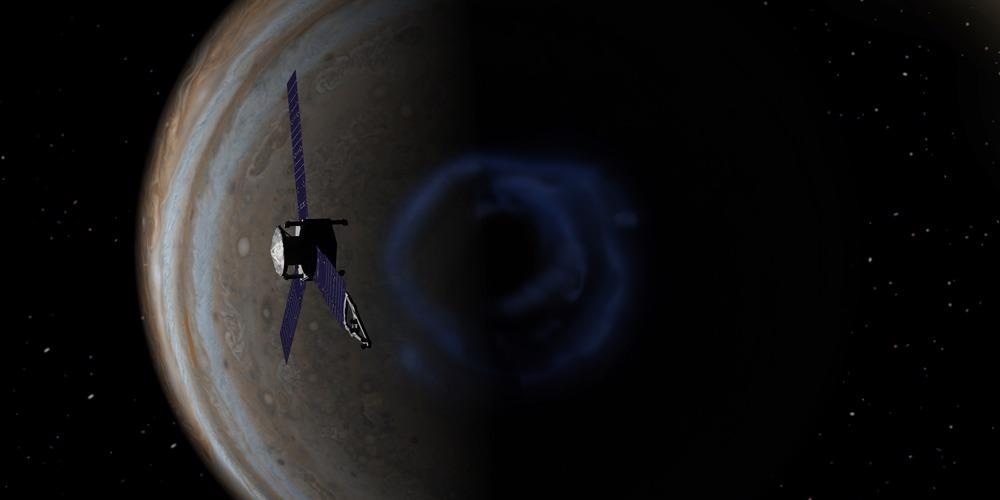An international team of astronomers may have finally cracked the 40-year mystery of Jupiter’s powerful and periodic X-ray flares.

Image Credit: Raymond Cassel/Shutterstock.com
Every few minutes Jupiter, the solar system’s largest planet, produces a burst of X-rays. This spectacular phenomenon has been a puzzle for astronomers for four decades since their discovery, but now an answer could be at hand.
A team of researchers led by University College London (UCL) and Chinese Academy of Sciences astronomers have found that the X-ray bursts from the gas giant, which occur roughly every 27 minutes, are triggered by periodic vibrations in its magnetic field lines. These vibrations cause waves of plasma which send heavy ion particles down magnetic fieldlines. Eventually, these field-surfing ions strike the planet’s atmosphere and release energy in the form of X-rays.
“We have seen Jupiter producing X-ray aurora for four decades, but we didn’t know how this happened. We only knew they were produced when ions crashed into the planet’s atmosphere,” says Dr. William Dunn of UCL’s Mullard Space Science Laboratory.
Now we know these ions are transported by plasma waves — an explanation that has not been proposed before, even though a similar process produces Earth’s own aurora."
Dr. William Dunn
Excitingly, the team believes that the phenomenon may also be occurring around other planets. “It could, therefore, be a universal phenomenon, present across many different environments in space,” Dunn continues.
The team was able to crack the puzzle of Jupiter’s periodic X-ray bursts by combining observations of Jupiter made by the NASA-operated Juno satellite which is in orbit around the gas giant with measurements taken in the X-ray band of the electromagnetic spectrum by the European Space Agency’s (ESA) XMM-Newton observatory in orbit around Earth.
Along with Dr. Zhonghua Yao of the Chinese Academy of Sciences, Dunn is the lead author of a study discussing the team’s findings published in the journal Science Advances¹. The findings could spark a new era in our understanding of the physics of ionized gases or plasmas.
Jupiter: A Natural Laboratory for Studying Plasma
The fact that Jupiter has a rapidly rotating, strong magnetic field means that it is a natural laboratory ideal for the study of high-energy plasmas. One of the clearest effects arising from these plasmas is the X-ray flares investigated by the team.
The flares are part of the gas giant’s aurora, which arises when charged particles strike the planet’s atmosphere. A similar effect can be seen when charged particles strike Earth’s atmosphere and give rise to the colorful atmospheric display known as the northern lights.
The X-ray auroras around Jupiter occur roughly every 27 minutes at the northern and southern poles of the gas giant. The heavy ions that pummel the atmosphere originate from volcanic gas produced by the giant volcanoes on the Jovian moon of Io.
When this gas arrives at Jupiter, violent collisions rip electrons away from atoms, creating ionized gas or plasma. This plasma arranges itself in a torus, a doughnut-like ring, around the planet.
The X-ray flares have remained a puzzle for astronomers for more than 40 years because such powerful outbursts are not usually associated with planets. The fact that this association has been made means astronomers now have a good opportunity to study such phenomena ‘up close.’
“X-rays are typically produced by extremely powerful and violent phenomena such as black holes and neutron stars, so it seems strange that mere planets produce them too,” says Professor Graziella Branduardi-Raymont, also hailing from UCL’s Mullard Space Science Laboratory. “We can never visit black holes, as they are beyond space travel, but Jupiter is on our doorstep.
“With the arrival of the satellite Juno into Jupiter’s orbit, astronomers now have a fantastic opportunity to study an environment that produces X-rays up close.”
Despite the discovery of the mechanism behind the X-ray bursts being uncovered, the team points out that there are still Jovian outburst mysteries to be solved.
Jupiter’s Remaining X-Ray Puzzles
The Juno and XMM-Newton satellites observed Jupiter and its atmosphere continuously for a 26-hour period to discover the correlation between the gas giant’s X-ray flares and waves in its plasma ring. The researchers then employed computer modeling procedures to confirm these waves could steer heavy ions towards the Jovian atmosphere.
One lingering puzzle surrounding the phenomenon is why the magnetic field lines of Jupiter vibrate periodically. The team believes this could be the result of interactions with the Sun’s solar winds or from plasma flowing within the magnetosphere of Jupiter.
Though both Earth and Jupiter possess magnetospheres, the Jovian magnetic field is around 20,000 times stronger than that of our planet. This means that the area that it dominates is also considerably larger and if it were visible in the night sky, it would occupy a region several times larger than our moon.
The team will now attempt to study this phenomenon in greater detail, an investigation that could include other planets within the solar system and beyond.
“Now we have identified this fundamental process, there is a wealth of possibilities for where it could be studied next,” says Yao. “Similar processes likely occur around Saturn, Uranus, Neptune and probably exoplanets as well, with different kinds of charged particles ‘surfing’ the waves.”
References and Further Reading
Yao. Z., Dunn. W. R., Woodfield. E. E., et al, [2021], ‘Revealing the source of Jupiter’s x-ray auroral flares,’ Science Advances, [DOI: 10.1126/sciadv.abf0851]
Disclaimer: The views expressed here are those of the author expressed in their private capacity and do not necessarily represent the views of AZoM.com Limited T/A AZoNetwork the owner and operator of this website. This disclaimer forms part of the Terms and conditions of use of this website.